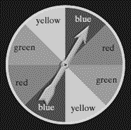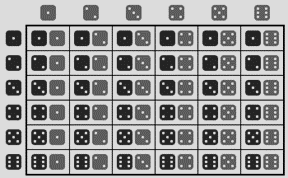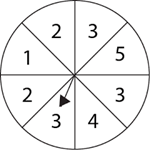Section PC.1 – Types of Probability Practice Problems
Write answers as whole numbers or simplified fractions unless otherwise noted.
1. Suppose you roll a six-sided die. Determine the following:
a. P(rolling a 5)
b. P(rolling an even number)
c. P(rolling a number bigger than 2)
2. Compute the probability of tossing a six-sided die and getting a 7.
3. Compute the probability of tossing a six-sided die and getting a number less than 3.
4. Compute the probability of rolling a 12-sided die and getting a number other than 8.
5. A ball is drawn randomly from a jar that contains 6 red balls, 2 white balls, and 5 yellow balls. Find the probability of the given event:
a. A red ball is drawn
b. A white ball is drawn
6. A bag contains 2 gold marbles, 10 silver marbles, and 25 black marbles. You randomly select one marble from the bag. What is the probability that you select a gold marble?
7. Suppose you write each letter of the alphabet on a different slip of paper and put the slips into a hat. What is the probability of drawing one slip of paper from the hat at random and getting:
a. A consonant
b. A vowel
8. A group of people were asked if they had run a red light in the last year. 150 responded “yes”, and 185 responded “no”. Find the probability that if a person is chosen at random, they have run a red light in the last year.
9. In a survey, 205 people indicated they prefer cats, 160 indicated they prefer dogs, and 40 indicated they don’t enjoy either pet. Find the probability that if a person is chosen at random, they prefer cats.
10. If you pick one card at random from a standard deck of 52 cards, what is the probability it will be a King?
11. If you pick one card at random from a standard deck of 52 cards, what is the probability it will be a Diamond?
12. If you pick one card at random from a standard deck of 52 cards, what is the probability it will be an 8?
13. If you pick one card at random from a standard deck of 52 cards, what is the probability it will be a face card?
14. If you pick one card at random from a standard deck of 52 cards, what is the probability it will be number a number greater than 5 and less than 10?
15. A fair coin is tossed three times in succession. The set of equally likely outcome is {HHH, HHT, HTH, THH, TTH, THT, HTT, TTT}. Find the probability of getting:
a. exactly one head
b. exactly two tails
c. exactly two heads
d. at least one head
e. at least two tails
f. the same outcome on each toss
g. fewer than four tails
h. four heads
16. Find the probability that the spinner lands in a red region. Assume that it is equally probable that the pointer will land on any one of the ten colored regions. If the pointer lands on a borderline, spin again.

17. The table below shows data collected in a college classroom. Find the probability that a student chosen at random:
a. Bikes
b. Drives a car
c. Rides the bus
d. Walks
| Means of Transportation | Number of Students |
| Bike | 7 |
| Car | 2 |
| Bus | 5 |
| Walk | 6 |
18. A single die is rolled twice. The 36 equally likely outcomes are shown as follows:

Find the probability of getting:
a. two odd numbers
b. two even numbers
c. two numbers whose sum is 7
d. two numbers whose sum is 8
e. two numbers whose sum exceeds 3
f. two numbers who sum is less than 3
19. Using the following table, find the probability, as a decimal rounded to the nearest hundredth, of:
| Taking Statistics | Not Taking Statistics | Total | |
| Male | 84 | 145 | 229 |
| Female | 76 | 134 | 210 |
| Total | 160 | 279 | 439 |
a. selecting male taking statistics
b. selecting a female not taking statistics
c. selecting a male
d. selecting someone taking statistics
20. Using the following table, find the probability of rolling a:
| Outcome | Frequency |
| 1 | 16 |
| 2 | 20 |
| 3 | 22 |
| 4 | 10 |
| 5 | 18 |
| 6 | 14 |
| Total | 100 |
a. three
b. a number less than 3
21. An American roulette wheel has 38 slots: two slots are numbered 0 and 00, and the remaining slots are numbered from 1 to 36. Find the probability that the ball lands in an even-numbered slot.
a. Write your answer as a whole number or simplified fraction
b. Write your answer as a decimal, rounded to the nearest thousandth
c. Write your answer as a percent, round to the nearest tenth of a percent
22. Use the spinner below. Find the probability of landing on an odd number. Assume that it is equally probable that the pointer will land on any one of the regions. If the pointer lands on a borderline, spin again.
23. Write your answer as a percent rounded to the nearest tenth.


